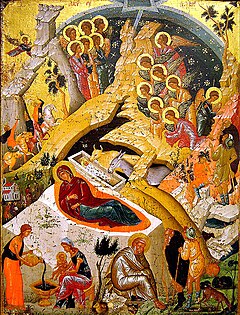Christmas in Romania
This article needs additional citations for verification. (October 2020) |
| Christmas in Romania | |
|---|---|
| Official name | Crăciunul în România |
| Observed by | 25 December |
| Next time | 25 December 2024 |
| Frequency | annual |
| Related to | Advent |
Christmas in Romania (
The
Advent

The seven-week
During this season, the Christmas holiday season in
The next day, December 1, is the
At the beginning of December, the
On December 20, Saint Ignatius Day, Romanians start the last preparations for Christmas. On this date, they cut
On December 24, Christmas Eve - Noaptea de ajun - is traditionally the day children usually start caroling their neighbors.[14] On the same date, women bake traditional cookies to give children for their caroling. By that time, the Christmas tree must usually be already decorated. Those more pious attend the Royal Hours and the afternoon Divine Liturgy before preparing for dinner.
Christmas music
This section needs additional citations for verification. (October 2020) |
Music is an important part of Christmas celebration all over Romania. There is a special genre of music, related to
In traditional Romanian rural society, preparations for colinde started well in advance (sometimes weeks) before Christmas. The village youth (usually boys) would begin to form groups in different places and designate a leader to practice singing in unison. These groups are called cete de colindători, and their numbers vary from region to region.
Then, starting on Christmas Eve, the groups would go to different houses and begin singing. In some villages, they go first to the mayor's house, followed by the teacher's house, whereas in other parts there is no pre-established order. The families would then invite them into the house and give them different small gifts such as nuts, dried fruits, and pretzels. There are also adaptations from international hit carols into Romanian, for example "Noapte de vis" (from "Silent Night") or "O, brad frumos!" (from "O Tannenbaum").
Examples of colinde with religious subject are "Astăzi s-a născut Hristos" (Today
Apart from the religious songs, there are also many other original colinde about subjects like Joy,

Many folklore musicians covered, re-mastered or did renditions to those songs, some of them being well-known artists such as
Singer
In late 2009, Bănică, Jr starred in a
A lot of compilations have been released for Christmas in Romania, for example, the "
Starting in 2010, a special
Christmas food
This section needs additional citations for verification. (October 2020) |
During Christmas, Romanians bake or buy various special dishes, including desserts and sweets. Romanians most usually bake
and many other ingredients, flavors, condiments and additions. There are several types of spongecakes, with hundreds of recipes. You can either knead it for hours to be ready in 6 hours, or you can let it rise for 1 hour to avoid kneading it. You can fill the sponge cake with walnuts, cocoa, raisins, Turkish delight and in Transylvania: poppy seed paste (cozonac cu mac). Plates heaped with small pastries and cakes (corni și baclava) are prepared to serve to carollers when they call.A molded vegetable and chicken salad held together with mayonnaise and decorated with olives and boiled eggs are often prepared. It is called Salată de boeuf from the French, although it usually does not contain beef.
Other Christmas dishes include piftie, sarmale, and pork dishes.
See also
- Christmas worldwide
- Public holidays in Romania
References
- ^ a b c "Postul Craciunului". Crestin Ortodox. CrestinOrtodox.ro. November 14, 2011. Retrieved December 8, 2011.
- ^ "Lasata Secului pentru Postul Craciunlui". November 14, 2011. Retrieved December 8, 2011.
- ^ "Ajunul Bobotezei, zi de post aspru". Archived from the original on April 6, 2012. Retrieved December 8, 2011.
- ^ "Posturi peste an". calendarortodox. December 8, 2011. Archived from the original on March 3, 2016. Retrieved December 7, 2011.
- ^ "Tradiţii pentru spor şi sănătate de Sfântul Apostol Andrei". Observator. observator.ro. November 28, 2011. Archived from the original on March 6, 2016. Retrieved December 8, 2011.
- ^ a b "Ziua Sfantului Andrei - sarbatoarea magiei, a strigoilor si a descantecelor de dragoste". December 8, 2011.
- ^ CIA World Factbook, Romania - Government[dead link]
- ^ Romanian Institute for Cultural Remembrance, The Resolution of the National Assembly in Alba Iulia on December 1, 1918 Archived June 8, 2011, at the Wayback Machine
- ^ "3 milioane de telespectatori au fost alături de ProTv de Ziua Naţională". CM. zf.ro. December 2, 2011. Retrieved December 8, 2011.
- ^ Inna on Maruta Archived 2012-04-26 at the Wayback Machine
- ^ Povestea lui Mos Nicolae Archived 2011-12-07 at the Wayback Machine
- ^ a b "Mos Nicolae". Retrieved December 8, 2011.
- ^ La Ignat, cand se taie porcii
- ^ Sărbătorile de iarnă în Bucovina, e noaptea Sfântului Ajun! Archived 2012-06-04 at the Wayback Machine


